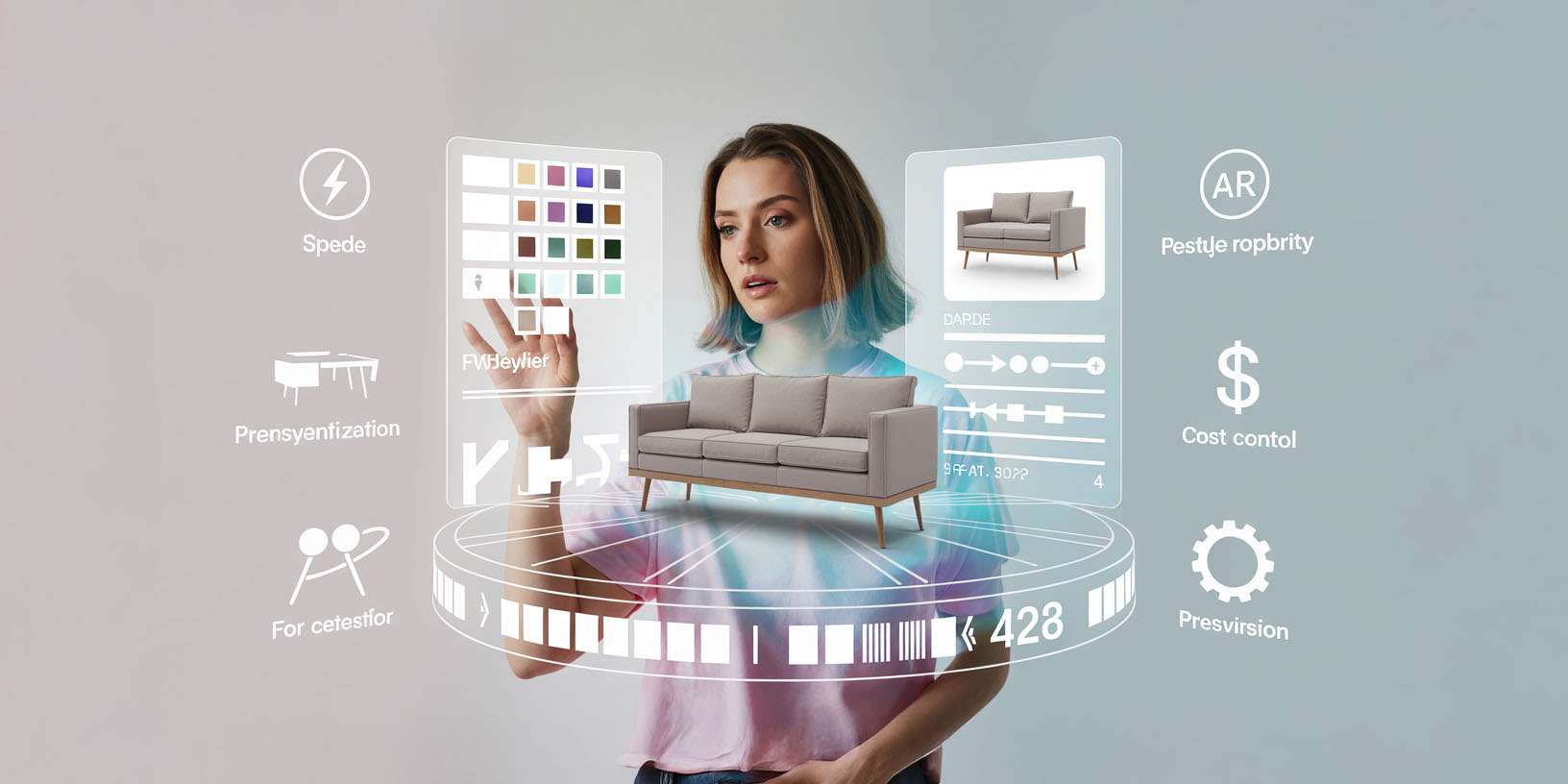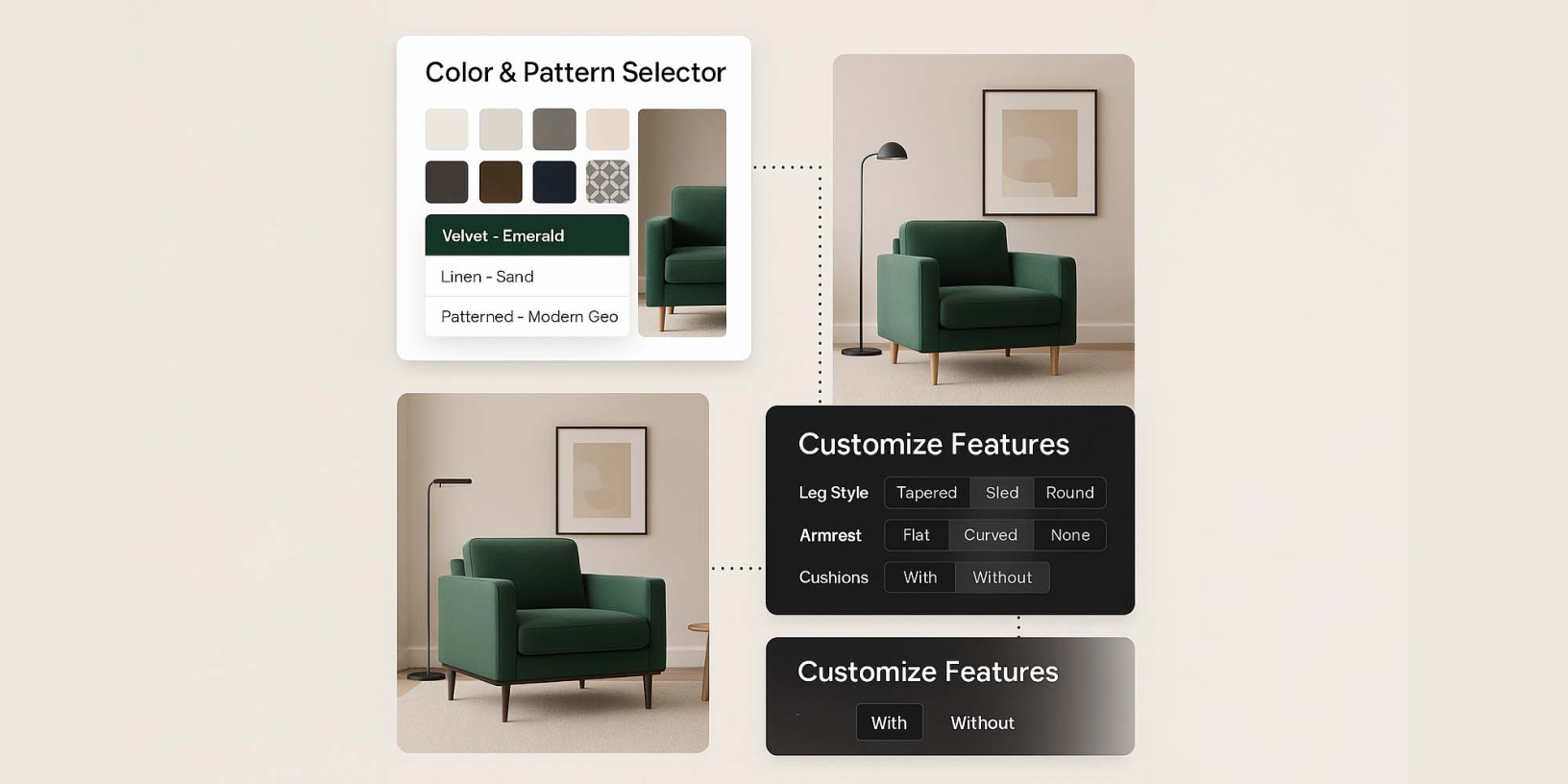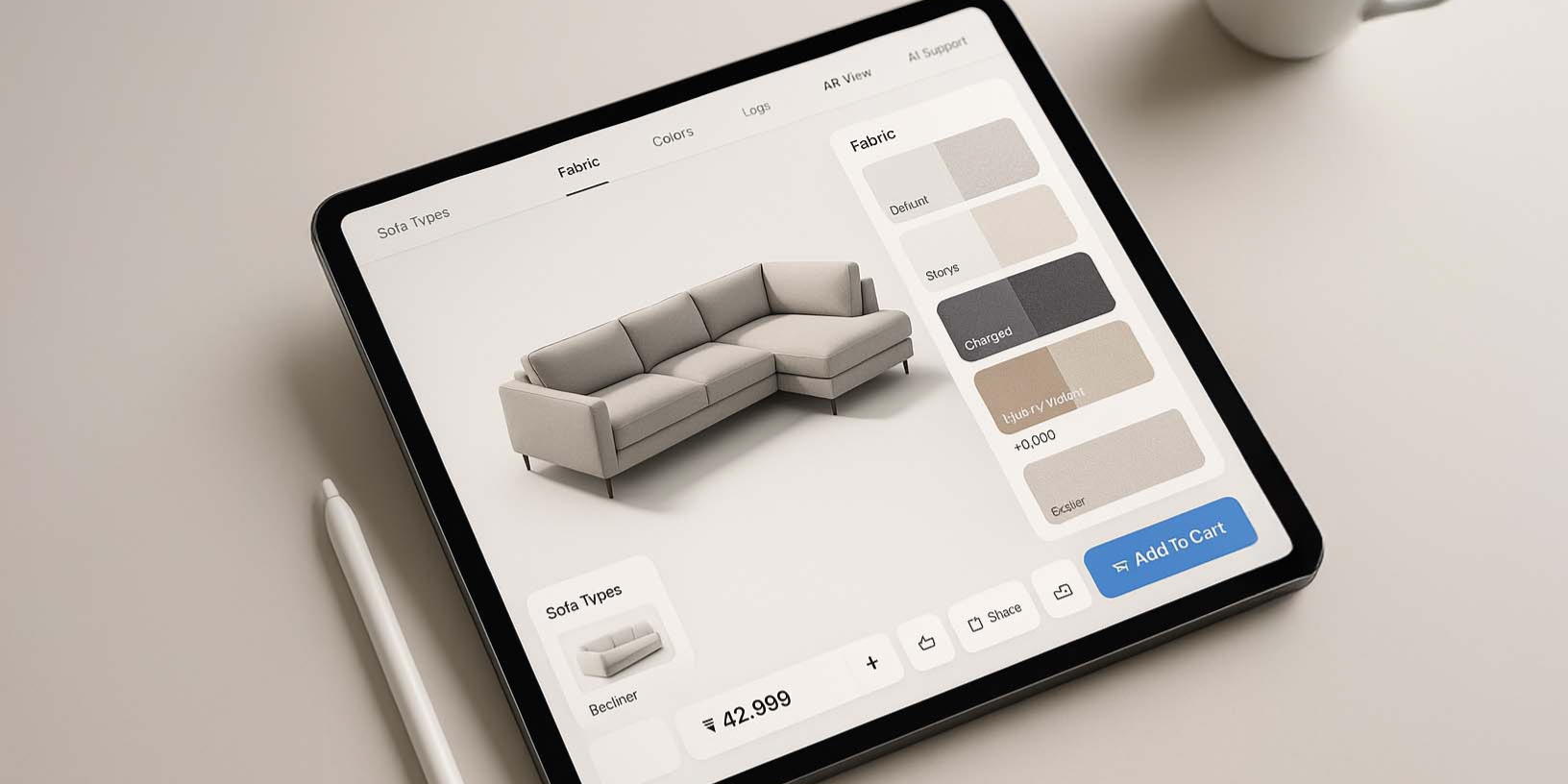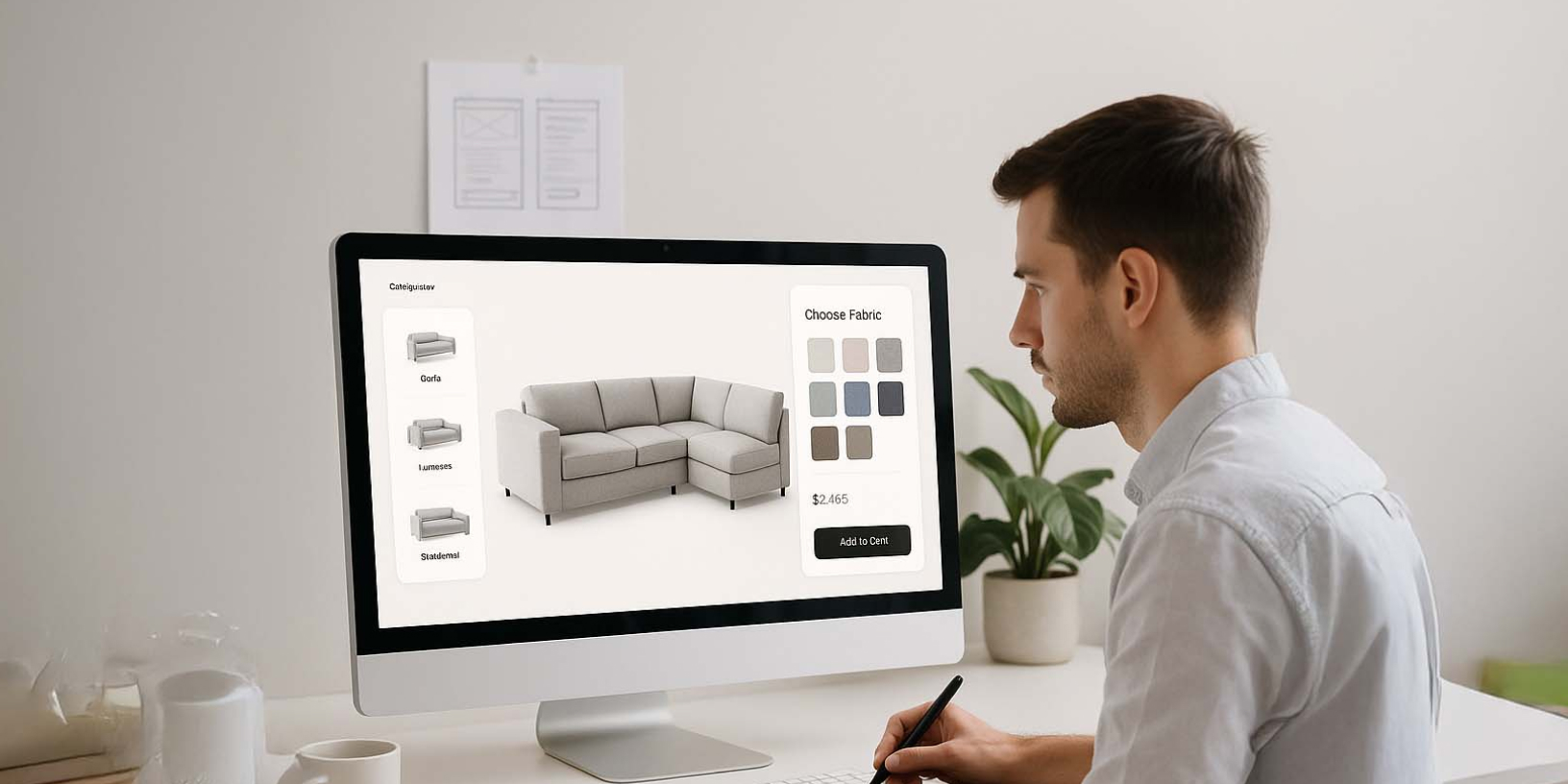

Introduction
This blog explores the transformation of online furniture shopping through advanced 3D and AR technologies. It highlights how 3D furniture configurators allow customers to customize furniture in real-time, adjusting materials, colors, and dimensions, while AR enables virtual placement in real-world spaces. The blog covers key benefits like enhanced engagement, higher conversions, and reduced returns, alongside features, use cases, challenges, and future trends such as AI personalization and VR showrooms, emphasizing the strategic importance of these tools for furniture brands.
The Evolution of Online Furniture Shopping and the Rise of 3D & AR
The furniture industry has transformed significantly in the digital era. Once reliant on in-store visits, fabric swatches, and tape measures, the sector now thrives on clicks, taps, and immersive technology. Over the past decade, online furniture shopping has evolved from a convenience to a customer expectation. Simple e-commerce platforms with static images have given way to competitive spaces driven by innovation, customization, and virtual experiences.
Initially, customers hesitated to purchase big-ticket items like sofas or dining tables without seeing them in person. Dimensions, colors, and textures are critical in home design, and traditional websites struggled to provide the tactile confidence needed. However, consumer behavior has shifted due to improved logistics, generous return policies, and the demand for digital-first experiences. Today, shoppers expect to explore furniture from home, at any time, with tools that offer a realistic sense of ownership.
This shift has fueled the demand for customization and immersive experiences. Customers want furniture tailored to their space, style, and taste, whether furnishing a cozy apartment or an entire office. This has given rise to 3D product configurators, enabling users to customize furniture in real-time—adjusting fabrics, finishes, dimensions, or modular sofa layouts with intuitive, visual tools.
Augmented Reality (AR) takes this further by allowing users to place virtual furniture in their real-world environment via a smartphone or tablet. This eliminates guesswork, letting customers see how a piece fits with existing decor, reducing return rates and boosting satisfaction. Retailers adopting AR report stronger brand engagement and fewer returns.
In this competitive landscape, furniture brands and interior design firms must move beyond digital catalogs. The future belongs to businesses embracing immersive technology—blending high-quality 3D visuals, real-time customization, and AR-powered interaction. Hexacoder specializes in developing these solutions, helping brands bridge the gap between imagination and purchase. A 3D configurator is not just a feature—it’s a modern necessity.
What Is a 3D Furniture Configurator and Why It Matters
A 3D furniture configurator is an interactive digital tool that lets users customize furniture in real-time using a visual 3D interface. Unlike static product pages with limited photos, a 3D configurator empowers customers to adjust materials, colors, dimensions, layouts, and add-ons directly in the browser, transforming passive viewing into an active design experience.
In online furniture retail and interior design, a 3D configurator bridges imagination and reality. Customers can visualize a sectional sofa in velvet instead of leather, change a dining table’s finish, or experiment with chair leg styles instantly, without guesswork or sales assistance.
Key features of a 3D furniture configurator include:
- Real-Time Rendering: The 3D model updates live as users select options, offering an accurate preview from every angle, boosting buyer confidence.
- Customizable Options: Users can switch materials (wood, metal, fabric), colors, finishes, and dimensions with preset or freeform inputs.
- Intuitive UI/UX: Designed for non-technical users, with drag-and-rotate views, zoom functionality, and guided steps for a smooth experience.
- Mobile & AR Compatibility: Integrates with AR to place customized furniture in physical spaces via smartphones or tablets.
- Pricing Updates: Displays real-time pricing changes as designs are tweaked, aiding budget-conscious decisions.
Compared to traditional product listings with limited images and dropdown menus, a 3D configurator eliminates the imagination gap, showing exactly what each choice looks like. This enhances engagement, reduces uncertainty, lowers return rates, and improves satisfaction. For brands, configurators reduce inventory and photography costs while enabling flexible, made-to-order product lines.
Key Benefits of 3D Furniture Configurators

Enhanced Engagement, Higher Conversions, Fewer Returns & More
In today’s competitive digital marketplace, furniture brands need standout customer experiences. A 3D furniture design configurator delivers this by allowing shoppers to personalize furniture in real-time, offering engagement, confidence, and satisfaction that traditional e-commerce can’t match. Here are four major benefits:
Enhanced User Engagement
Modern shoppers crave interaction. A configurator turns passive browsing into a hands-on journey, letting users rotate, zoom, and customize furniture—adjusting colors, fabrics, sizes, and accessories. This keeps customers on the site longer, encouraging exploration and connection with the brand. A Deloitte study found interactive product pages increase time spent on site by 50%, a key indicator of interest and potential conversion.
Increased Sales Conversions
Uncertainty is a major barrier to online furniture sales. Will the color match the walls? Will the size fit the room? A 3D configurator provides a realistic preview, reducing cart abandonment and boosting conversions. Real-time pricing updates help customers stay within budget while tailoring designs, leading to higher conversion rates and value-driven purchases.
Reduced Return Rates
Returns are costly in logistics and brand perception. A major cause is mismatched expectations. Configurators narrow this gap by letting customers build and view their selections from multiple angles, often with AR. Brands using 3D tools report up to 30% reductions in return rates, improving efficiency and customer happiness.
Brand Differentiation and Loyalty
In a saturated market, a 3D configurator signals innovation and customer focus, attracting new customers and building loyalty. Shoppers are more likely to return to and recommend brands that empower co-creation, creating a personalized, forward-thinking experience aligned with modern lifestyles.
Web-Based Furniture Customization

How Online Configurators Work Without Apps
Customers want to build, not just browse. A web-based 3D furniture configurator offers powerful customization tools accessible directly through a browser—no app downloads or installations needed. Here’s how it works and why it’s effective:
Browser-Based Accessibility – No Apps Required
Web-based configurators are instantly accessible on desktops, tablets, or smartphones, improving user adoption and enabling seamless traffic from ads, social media, or email campaigns. Brands can update product options, pricing, or designs in real-time without app store delays, making it scalable for small businesses and enterprises alike.
Interactive UI/UX for Non-Tech-Savvy Users
Great technology feels simple. Configurators guide users through selecting base models, finishes, dimensions, and accessories with a clean, intuitive interface. Buttons are clear, tooltips offer suggestions, and the 3D model responds instantly. Built-in validation ensures compatible selections, avoiding frustration or errors, and empowering non-technical users to design confidently.
Integration with E-commerce Platforms
Configurators integrate seamlessly with platforms like Shopify, WooCommerce, Magento, or custom systems, embedding into product pages or acting as modular widgets. Once a design is finalized, the tool passes configuration, pricing, SKU details, and images to the shopping cart, streamlining purchasing and syncing with fulfillment, inventory, and pricing systems. Advanced configurators connect with CRM, lead capture, or ERP systems for complex workflows like quote generation or personalized marketing.
User Experience and Accessibility
Making 3D Tools Easy for Everyone
Great technology feels simple. Configurators guide users through selecting base models, finishes, dimensions, and accessories with a clean, intuitive interface. Buttons are clear, tooltips offer suggestions, and the 3D model responds instantly. Built-in validation ensures compatible selections, avoiding frustration or errors, and empowering non-technical users to design confidently.
Integration with E-Commerce Platforms
Seamless Checkout, SKU Mapping, and Real-Time Data
Configurators integrate seamlessly with platforms like Shopify, WooCommerce, Magento, or custom systems, embedding into product pages or acting as modular widgets. Once a design is finalized, the tool passes configuration, pricing, SKU details, and images to the shopping cart, streamlining purchasing and syncing with fulfillment, inventory, and pricing systems. Advanced configurators connect with CRM, lead capture, or ERP systems for complex workflows like quote generation or personalized marketing.
Augmented Reality (AR) in Furniture Shopping
Visualizing Custom Furniture in Real-World Spaces
AR is a game-changer in digital furniture retail, placing customized pieces into a customer’s real-world environment via a smartphone or tablet. It bridges the context gap, letting users walk around virtual furniture, view it from different angles, and assess how it pairs with decor, mimicking a physical showroom from home.
Benefits for Spatial Awareness and Room Planning
AR solves spatial awareness challenges by:
- Improving layout decisions: Users can move virtual objects to find the perfect spot.
- Preventing design clashes: Customers see if new pieces complement existing decor.
- Boosting buyer confidence: Visualizing items in their space increases purchase likelihood.
This leads to fewer returns, faster conversions, and a more personalized experience.
Hexacoder AR Solutions
Hexacoder’s AR furniture visualization tools complement our 3D configurators, offering:
- WebAR (No App Required): AR experiences launch directly from mobile browsers.
- iOS and Android Compatibility: Supports ARKit and ARCore for seamless rendering.
- Real-Scale Visualization: Furniture appears to scale in the user’s space.
- AR-Integrated Configurator: Configure in 3D and preview in AR instantly.
AR is a strategic tool to enhance engagement and reduce uncertainty, providing next-generation shopping experiences.
Essential Features to Look For
High-Fidelity Models, Drag-and-Drop, AR, Real-Time Pricing
Choosing the right configurator impacts customer experience, brand perception, and sales. Key features include:
- High-Fidelity 3D Models: Photorealistic visuals with shadows, textures, and details replicate in-person examination. Hexacoder uses advanced rendering and optimized geometry for beautiful models without compromising performance.
- Drag-and-Drop UI: An intuitive drag-and-drop interface lets users swap cushions, reposition modules, or combine parts, providing tactile control and deeper engagement.
- Real-Time Pricing and Product Updates: Real-time updates on price, weight, and availability reduce checkout friction. Hexacoder configurators integrate with back-end systems for seamless feedback.
- Save/Share Options for Design: Saving, downloading, or sharing designs via links, PDFs, or user accounts supports collaborative buying, increasing engagement and conversions.
- Compatibility with Mobile Devices and AR Viewers: Responsive configurators work across devices and support AR viewers like ARKit and ARCore for seamless customization-to-placement transitions. Hexacoder uses WebGL and WebAR for smooth cross-platform performance.
Use Cases by Furniture Sector
Home, Office, Outdoor, and Modular Furniture Brands
3D configurators are standard across furniture sectors, meeting modern customer expectations.
Home & Office Furniture Brands

Residential and office furniture companies use configurators to let customers customize size, color, and functionality. For example, a home office buyer can match a desk’s wood finish to flooring, while a residential buyer can test sofa layouts and fabrics. Hexacoder tailors configurators for living room sets, office setups, and storage solutions.
Outdoor & Modular Furniture Businesses
Outdoor furniture brands address aesthetic and environmental concerns, letting users test materials and cushions in realistic settings or AR. Modular furniture companies showcase flexibility, allowing users to drag and combine components. Brands like Ligne Roset, Lovesac, and Burrow use configurators to highlight modularity while ensuring manufacturability.
Challenges in Implementing 3D Configurators
Budget, 3D Assets, and Mobile Optimization
Implementing configurators involves challenges that require strategic planning.
Cost of Development and Implementation
High-quality configurators require investment in 3D modeling, front-end development, rendering, and backend integration. Costs vary by complexity and platform needs. Hexacoder offers modular development plans to manage costs and scale functionality.
Need for 3D Assets and Accurate Models
Photorealistic, optimized 3D assets are critical but resource-intensive. Creating variants for customizable options multiplies asset needs. Hexacoder provides asset pipelines and optimization workflows to maintain quality and manageability.
Loading Speeds and Mobile Performance
Slow-loading configurators increase bounce rates. Developers must use model compression, lazy loading, progressive rendering, and device-based optimization. Hexacoder’s WebGL-based engines ensure smooth mobile performance without sacrificing visuals.
Future Trends in 3D Configuration
AI, VR Showrooms, Smart Homes, and Sustainability

3D configurators are evolving into intelligent, immersive platforms. Emerging trends include:
AI-Driven Personalization
AI analyzes preferences and room photos to suggest tailored designs, automating choices and reducing decision fatigue for a frictionless experience.
Virtual Reality (VR) Showrooms
VR offers immersive environments to explore collections and test arrangements, ideal for high-end brands and remote consultations.
Integration with Smart Home Tools
Configurators will integrate with IoT devices, enabling furniture to adapt to smart home ecosystems, like desks adjusting height via wearables.
Sustainable Design Simulations
Configurators will show environmental impacts, letting users explore eco-friendly options and align with sustainability goals.
Conclusion
3D furniture configurators are reshaping furniture shopping by driving engagement, boosting conversions, reducing returns, and differentiating brands. They empower buyers to personalize products with confidence, using real-time visuals and AR to eliminate uncertainty. Adopting a configurator is a strategic advantage, signaling innovation and customer-centricity.
To transform your furniture sales and deliver unforgettable experiences, invest in a custom 3D furniture configurator. Contact Hexacoder to get started.
Use the buttons above to share this article on various social platforms or copy the direct link.



